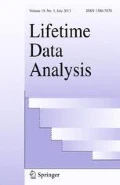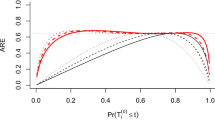Abstract
There are few readily-implemented tests for goodness-of-fit for the Cox proportional hazards model with time-varying covariates. Through simulations, we assess the power of tests by Cox (J R Stat Soc B (Methodol) 34(2):187–220, 1972), Grambsch and Therneau (Biometrika 81(3):515–526, 1994), and Lin et al. (Biometrics 62:803–812, 2006). Results show that power is highly variable depending on the time to violation of proportional hazards, the magnitude of the change in hazard ratio, and the direction of the change. Because these characteristics are unknown outside of simulation studies, none of the tests examined is expected to have high power in real applications. While all of these tests are theoretically interesting, they appear to be of limited practical value.



Similar content being viewed by others
References
Aitkin M, Laird N, Francis B (1983) A reanalysis of the Stanford heart transplant data. J Am Stat Assoc 78:264–274
Altman DG, de Stavola BL (1994) Practical problems in fitting a proportional hazards model to data with updated measurements of the covariates. Stat Med 13:301–341
Andersen PK (1992) Repeated assessment of risk factors in survival analysis. Stat Methods Med Res 1:297–315
Bender R, Augustin T, Blettner M (2005) Generating survival times to simulate Cox proportional hazards models. Stat Med 24:1713–1723
Breslow N (1974) Covariance analysis of censored survival data. Biometrics 30:89–100
Clark DA, Stinson EB, Griepp RB, Schroeder JS, Shumway NE, Harrison DC (1971) Cardiac transplantation in man, VI. Prognosis of patients selected for cardiac transplantation. Ann Internal Med 75:15–21
Cox DR (1972) Regression models and life tables. J R Stat Soc B (Methodol) 34(2):187–220
Crowley J, Hu M (1977) Covariance analysis of heart transplant survival data. J Am Stat Assoc 72:27–36
Fisher LD, Lin DY (1999) Time-dependent covariates in the Cox proportional-hazards regression model. Ann Rev Public Health 20:145–157
Grambsch PM, Therneau TM (1994) Proportional hazards tests and diagnostics based on weighted residuals. Biometrika 81(3):515–526
Hosmer D, Lemeshow S, May S (2008) Applied survival analysis: regression modeling of time-to-event data. Wiley-Interscience, New York
Kalbfleisch JD, Prentice RL (2002) The statistical analysis of failure time data, 2nd edn. Wiley-Interscience, Hoboken
Leemis L, Shih LH, Reynertson K (1990) Variate generation for accelerated life and proportional hazards models with time dependent covariates. Stat Probab Lett 10:335–339
Lin J, Zhang D, Davidian M (2006) Smoothing spline-based score tests for proportional hazards models. Biometrics 62:803–812
Ng’andu N (1997) An empirical comparison of statistical tests for assessing the proportional hazards assumption of Cox’s model. Stat Med 16:611–626
Petersen RC, Thomas RG, Grundman M, Bennett D, Doody R et al (2005) Vitamin E and Donepezil for the treatment of mild cognitive impairment. N Engl J Med 352(23):2380–2388
Schoenfeld D (1980) Chi-square goodness of fit tests for the proportional hazards model. Biometrika 67:145–153
Therneau TM, Grambsch PM (2000) Modeling survival data: extending the Cox model. Springer, New York
Zhou M (2001) Understanding the Cox regression models with time-change covariates. Am Stat 55:153–155. http://www.ms.uky.edu/~mai/research/amst.pdf. Accessed 1 Aug 2013
Author information
Authors and Affiliations
Corresponding author
Rights and permissions
About this article
Cite this article
Grant, S., Chen, Y.Q. & May, S. Performance of goodness-of-fit tests for the Cox proportional hazards model with time-varying covariates. Lifetime Data Anal 20, 355–368 (2014). https://doi.org/10.1007/s10985-013-9277-1
Received:
Accepted:
Published:
Issue Date:
DOI: https://doi.org/10.1007/s10985-013-9277-1




